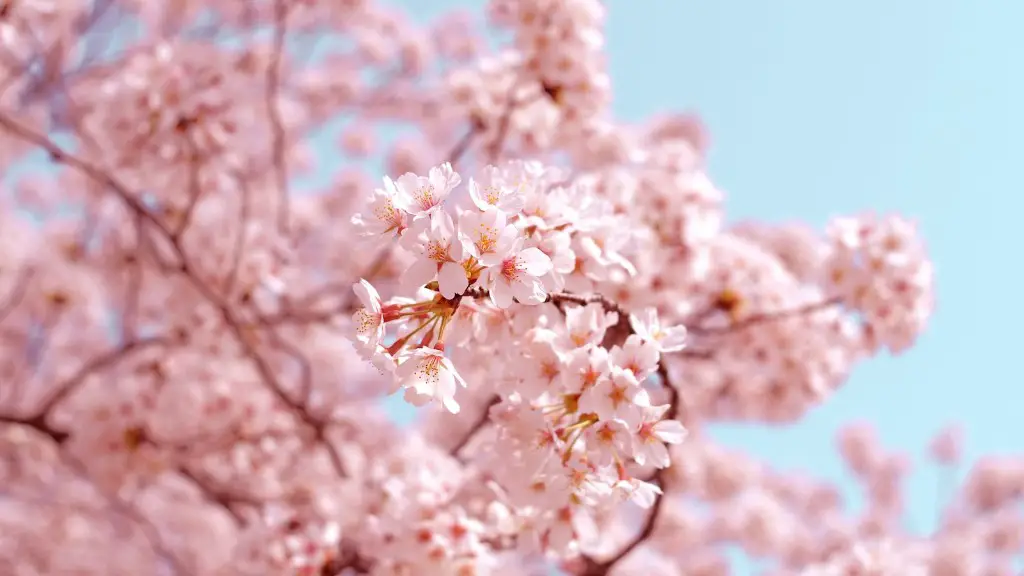Biology of the Cherry Tree
The cherry tree, scientifically known as Prunus avium, is a perennial tree belonging to the Rosaceae family. It is a drupe and is a species that is native to areas including Europe, western Asia, and parts of North Africa. It is a deciduous tree that grows from 4 to 10 meters in height and has a spread of 5 to 35 meters and is known for its clusters of small white flowers that bloom in the spring.
The cherry tree is considered easy to cultivate and is tolerant of a variety of soil conditions and regulations, making it a popular choice in many cities and states across the US and Europe. Its blossoms are produced during the blooming season, typically in April and May, and have become a symbol of spring, with their beautiful and fragrant profusion of small white to pink flowers. Its leaves are orb-shaped and usually have a duller, dark green color on the topside, while the reverse is lighter green.
The cherry tree produces small, dark-red to black fruits during the summer. This fruit, known as a drupe, contains a single large seed, which some people may refer to as a “stone” or “pit.” The tastes of the fruit can range from sweet and tart to sour depending on the variety. One of the best-known cherry varieties is the famous Maraschino cherry, used for a variety of food and beverage applications. Unripe cherries are also used in cooking for compotes, pies, and other desserts.
The cherry tree’s propagation process is simple and easily understood. It produces seeds from the fruits it produces in its lifetime. Many of these seeds germinate and sprout naturally in the forest or in cultivated areas. They can also be propagated in nurseries by sowing the seed. When the seedlings are ready, they are transplanted to the prepared area where they will be grown.
During the process of growth, the tree needs to be given ample space and adequate sunlight. It will also need to be watered regularly and provided with occasional fertilizer for best growth. If the conditions are favorable, cherry trees can live for up to 30-50 years or even longer. Protecting the sapling from pests, diseases, and other dangers will ensure the long life of the cherry tree.
Economic Significance of the Cherry Tree
Cherries are a popular commodity in the United States and abroad. The U.S. produces over 600 million pounds of cherries every year, making it the top producer of cherries in the world. It is also the largest exporter, sending frozen and canned cherries to countries around the world. The top five states in the U.S. for cherries in North America are Michigan, Washington, Oregon, California, and New York. The cherry tree is used by many farmers and households in the production and trading of these fruits, with some specializing in the sale of fresh cherries and others in the production of canned cherries or leaves.
Cherry farmers must pay attention to their trees to ensure a successful crop. They must monitor the weather and climate conditions, ensuring their orchards receive adequate water, nutrition, and pest control. Additionally, timely pruning is important to ensure better fruiting, greater yields, and maximum profitability. Once the cherries are harvested, farmers can market them either to grocery stores and supermarkets or directly to customers via online marketplaces or farmers’ markets.
The economic value of cherries has not gone unnoticed. The US Department of Agriculture recently invested in research to identify ways to improve cherry farming and increase the output of cherry farmers. This research is ongoing and is likely to produce even more profitable harvests in the near future, especially as more and more farmers adopt sustainable agricultural practices like organic farming.
Nutritional Benefits of the Cherry Tree
Cherries are packed with a variety of vitamins and minerals, including vitamins A and C, potassium, fiber, and magnesium. They are also a great source of antioxidants, consuming just one cup of cherries can provide up to 20% of your daily value for antioxidants. Studies indicate that these antioxidants can help to reduce inflammation and may even reduce the risk of certain types of cancer.
Cherries also contain a variety of other important nutrients. For example, they are an excellent source of melatonin, a hormone that has been linked to improved sleep quality. They are also one of the few food sources of anthocyanins, powerful antioxidants that can help to protect against cell damage and reduce the risk of several chronic diseases. Finally, cherries contain a compound called cyanidin, which has been linked to improved heart health and reduced cholesterol levels. In short, cherries are a great source of nutrition and are something that should be included in any healthy diet.
Environmental Impact of the Cherry Tree
Cherry trees are known to require a lot of energy and resources to produce. This can put a strain on the environment in a variety of ways. For starters, it requires a lot of water to cultivate cherry trees, which can put pressure on local water resources. Additionally, the use of pesticides and herbicides in the cultivation of the fruit can affect wildlife, as well as pollute waterways and the atmosphere. Further, many cherry farmers rely heavily on fossil fuels to transport their crops to market. Fortunately, these impacts can be greatly reduced with sustainable agricultural practices, such as organic farming and integrated pest management.
Additionally, cherry trees can have a positive impact on the environment. For starters, they are considered to be carbon sinks, meaning that they absorb some of the carbon dioxide produced by human activities. Additionally, the trees can provide habitats for local wildlife and shade for small animals. They also help to keep air and soil temperatures down, which can have a stabilizing effect on local ecosystems. Finally, many cherry orchards are left to grow naturally and wild-harvested, both of which provide a sustainable source of revenue for many communities.
Cultural Significance of the Cherry Tree
The cherry tree holds an important place in many cultures’ lore and is often used as a symbol of life, love, and beauty. For centuries, the bright colors, delicate petals, and sweet flavors of cherry blossoms have been celebrated in art, poetry, and folk tales. In Japan, for example, the blossoms of the cherry tree are strongly associated with the coming of spring and are a popular part of the country’s annual Hanami celebrations. In the Christian religion, cherries can represent the resurrection of Jesus. In Greek mythology, the cherry tree was associated with love and passion, while in Asia, cherry blossoms are believed to be a sign of long life.
The cherry tree is also a popular choice for gardeners and landscapers. Its bright colors and hardy nature make it a perfect choice for decorating patios, backyards, and other outdoor spaces. Additionally, its small fruits can be used in a variety of recipes, such as pies, jams, sauces, and liqueurs. In the United States, cherries are a popular accompaniment to summertime BBQs and other outdoor celebrations.
The Future of Cherry Tree Growth
Cherry trees are likely to remain popular in the coming years, as they are well adapted to a variety of climates and soil conditions. As more farmers adopt organic and sustainable practices, there is likely to be an increasing demand for cherry products. Additionally, research into the nutritional and health benefits of cherries is ongoing and is likely to produce a surge in popularity for the fruit in the coming years.
The rise of online marketplaces and other e-commerce solutions is also likely to contribute to the growth of the cherry industry. In recent years, these platforms have become popular sources for fresh fruits and vegetables, with many farmers taking advantage of the ability to reach a wider customer base. This will likely result in an increase in sales and profits for cherry farmers as more people get access to fresh, organic, and sustainably-sourced products.
Usefulness of the Cherry Tree
Cherry trees are highly useful and provide a variety of benefits to society. They provide us with a delicious and nutritious fruit and can be used in a variety of food and beverage applications. Their wood is strong and durable, and can be used in the construction of furniture and other items. Additionally, their blossoms can be used to make decorations and floral arrangements. Finally, the cherry tree has a strong cultural significance, as it is often used as a symbol of life, love, and beauty in many cultures.




